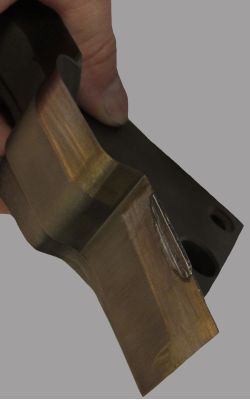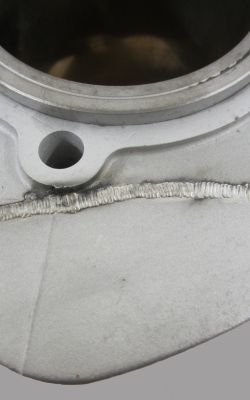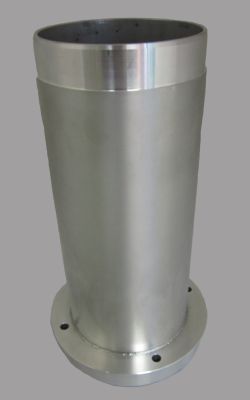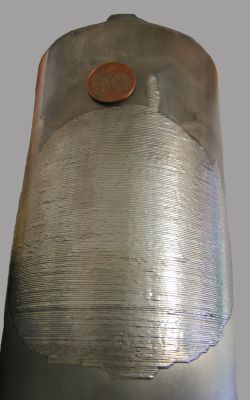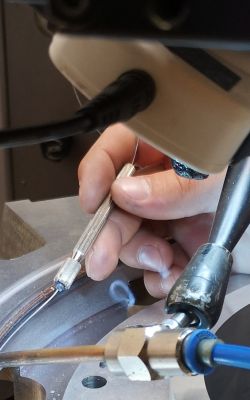Laser welding
At TM Lasertechnik we work in the field of laser welding with pulsed and CW laser welding systems. These enable extremely fast spot welding and also completely non-contact welding. Both the base material and a possible filler material are melted with the help of the concentrated light beam.
Due to the very high energy density in laser welding, the materials liquefy particularly quickly compared to other welding processes on the one hand, and on the other hand they also liquefy locally in a very limited manner. Without heating through the base material, they form a material-to-material bond. There is virtually no distortion. The weld seam is particularly fine. Reworking, meanwhile, is significantly reduced or even eliminated.
Depending on the intensity of the laser beam, a distinction is made between two different methods: heat conduction welding with shallow welding – e.g. for thin sheets and visible edges – or deep welding. Here, slim, deeply formed seams and high strengths are produced.
What is laser welding?
In laser welding or laser beam welding, energy is focused by means of focusing optics. This energy is then fed to the workpiece by a laser with a diameter of < 1 mm.
Work examples laser welding:
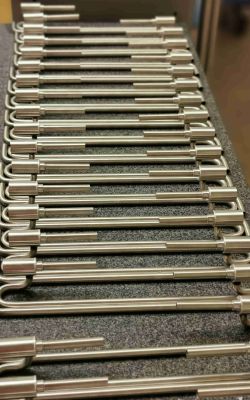

Series production valve body
Material: 1.4404
(chrome-nickel alloy).
With internal, very sensitive silicone seal. The pipe to be welded on is only approx. 5 mm from this seal.
The advantages
of laser welding:
Can also be used in the direct vicinity of thermo-sensitive materials such as plastics.
Very low heat-affected zone of max. 0.03 mm. Hardly any thermal stress, thus hardly any warpage.
High degree of automation through use of welding robots.
Hardly any spatter, weld bead or burr formation.
Very slim and complex seam geometry with highest, consistent quality. Multi-layer joints also possible.
Largest range of processable base materials and filler materials possible.
High welding and joining speed. Therefore particularly high efficiency (up to 8 times faster than TIG welding).
Mobile laser welding possible worldwide.
What do I need
laser welding?
We recommend our laser technology for almost all areas of application in which the highest precision and consistent quality with high cost-effectiveness are required.
Whether prototype construction, new part production, series production or repair services – laser welding enables an innumerable sum of solutions to join metals due to its variability.
In addition, deposition welding / laser cladding can be used to produce coatings for surface finishing.
Laser welding
from micro to macro
We use laser welding to join material thicknesses from 0.03 mm. The bandwidth ranges from components weighing several tons (turbine or mechanical engineering) to components weighing just a few grams (measurement and control technology / medical technology).
Regardless of the respective component dimensions and thicknesses, it is also possible to join material pairs with very different material thicknesses: For example, laser welding can be used to join a sheet of 0.1 mm to a solid component of 1 m or more with an accurate fit and without distortion.
Application areas of laser welding:
E-mobility
For example:
- Project support and consulting for all questions concerning laser welding.
- Contacting of battery cells and busbars.
- Contacting of sensors and thermocouples.
- Welding of car body parts.
Energy industry
For example:
- Welding of contacts and thermocouples for solar panels.
- Thin coating with silver on aluminum.
Mechanical engineering
For example:
- Welding of structural parts from 3D printing.
- Repair of shafts and flanges.
- Repair of compressor shafts and rotors.
Aerospace
For example:
- Project support and consulting on all issues related to laser welding.
- Prototyping.
- Welding on turbine parts.
Measurement & control
For example:
- Series welding of load cells with filler metal (1.4404).
- Series welding of thermocouples with filler metal (1.4404).
- Parts for analysis devices, without and with filler metal (1.4404), in series.
Turbine construction
For example:
- Repair welding of various gas turbine parts (blades, part joints, guide vane carriers, rivet strips).
- Welding on prototypes for aerospace turbines.
